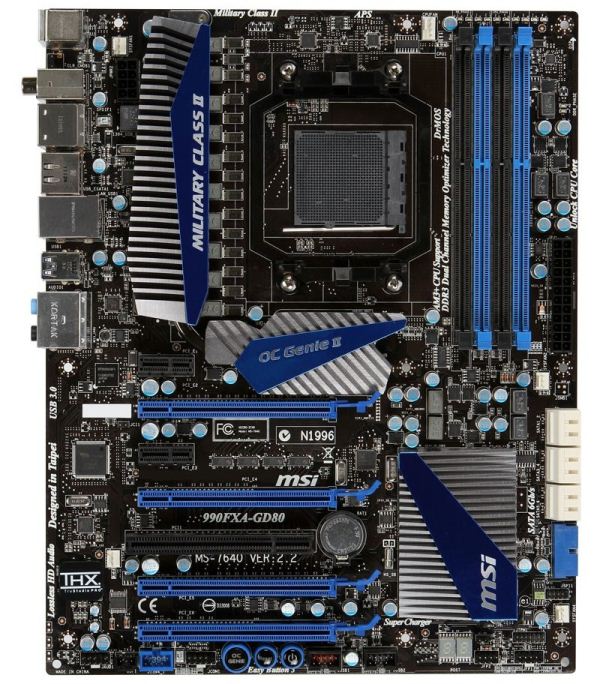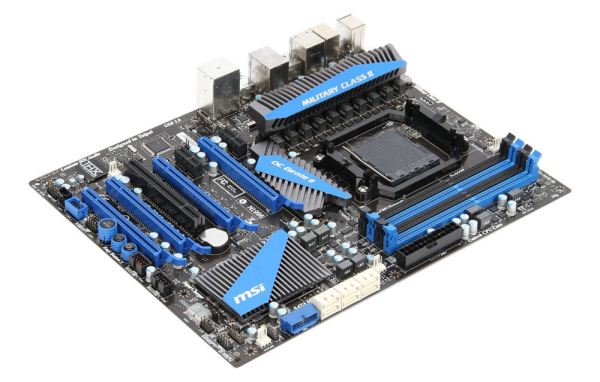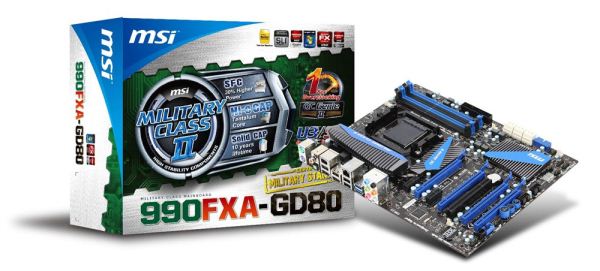990FX Motherboard Roundup with Thuban and Bulldozer – A Second Wind for ASUS, Gigabyte, MSI and Biostar
by Ian Cutress on April 5, 2012 11:00 AM ESTMSI 990FXA-GD80
Where the ASUS channel boards are called the LE, the standard, the Pro, and the Deluxe, Gigabyte has the UD3, UD4/H, UD5, UD7, UD9, and ASRock has Extreme3, Extreme4, Extreme6, Extreme7 and Extreme9. For MSI, this rears itself as a set of numbers preceded by the letters G or GD: we have the 80, 65, 55, 45, and 43, amongst others.
Channel boards are very important to all these manufacturers – they represent the bulk of consumer level sales whereas the gaming / overclocking / stability products are purely for niche environments. In most cases, the home user will only need a channel board, either at the high, medium or low end depending on need. So here we have the MSI 990FXA-GD80, which represents MSI’s higher end ‘mainstream’ offering.
The board itself currently e-tails for $195, slightly more than the ASUS Sabertooth 990FX and the Gigabyte 990FXA-UD5 in this combination review, but should offer a good comparison point. As it is up to $15 more than the Gigabyte, I hope that we can pin down where the $15 goes.
Overview
As a manufacturer, MSI has come up with some good products in their time (e.g. X79 Big Bang XPower II), and some that made me turn around and wonder ‘why?’ (e.g. the BIOS on the P67A-GD65). With our first look at some MSI AMD action in a fair while, I can say that while the 990FXA-GD80 is a nice board to work with, it is perhaps not the feature packed product to cover certain market areas. Do not get me wrong, MSI has some strong areas such as what comes In The Box with the board, however certain features like their fan header placement are not exactly optimal.
Performance wise, the MSI 990FXA-GD80 is no slouch, roughing it toe-to-toe with the other products we have in this review. Features such as the OC Genie, Power/Reset Buttons and a USB 3.0 header at right angles to the board are to be well received. The heatsink design and shape fits in well with the products image (despite the Military Class II paraphernalia obligatorily pasted across it), and the onboard PCIe layout has some thought behind it.
Users will note that different BIOS versions have different BIOS screens. If you update this beyond BIOS B5, the system will display the new graphical BIOS which MSI is very proud about (and it works rather well). However on startup, the board caused my AMD graphics cards (note, 5850s) to spin at 100% for several seconds. Somewhat odd behavior – the cards did not do this in other boards, and neither did our NVIDIA testing cards.
For overclocking, under Thuban the 990FXA-GD80 performed well giving respectable numbers. However while using the Bulldozer processor we were severely limited in terms of voltages and base frequency adjustments, limiting the range to which the overclocks can be performed. More on this is detailed in the Overclocking section.
This board, at $195, performs well for its money compared to other boards in its bracket, and with some bonuses in the box, would fit well into a 990FX system. With a few minor modifications/suggestions, this could have been the ultimate 990FX product, but nonetheless, I can see a lot of people using this board and enjoying it.
Visual Inspection
In keeping with MSI’s mainstream color scheme, the 990FXA-GD80 comes in with a distinct blue and black livery, sporting a very edge-heavy angular design on the heatsinks. The heatsinks, like on the previous three boards, provide a large amount of surface area and cover the VRMs to the left of the socket. This heatsink is connected via a heatpipe to another heatsink, in an effort to improve the cooling, and provide a little bit more advertising space on the board for features. The chipset heatsink is rather similar to that from the Gigabyte board, covering a large area of the board with fins but very low profile. It also all fits into the angular style.
In terms of the socket itself, despite the AM3 socket providing space, MSI has gone a bit further, giving more horizontal space than most other boards here and thus should not be an issue for large air coolers. For water coolers however the fan headers on board are neither that numerate (five in total) nor in ideal locations. The sole CPU header (4-pin) is next to the DIMMs in the top right of the socket, and the other socket fan header is above the 8-pin 12V header, but this is a 3-pin system header. Other fan headers on board are a 3-pin system fan header between the 24-pin ATX connector and the SATA ports, a 3-pin system fan header below the SATA ports (would be blocked by a GPU in the appropriate slot), and a three-pin system fan header to the left of the PCIe slots (would be blocked by an appropriate GPU). So if a user is running three large GPUs in this board, two fan headers instantly become inaccessible.
Down the right hand side of the board, below the 24-pin ATX power connector, are our SATA ports. MSI has decided to keep the standard set of six SATA 6 Gbps from the chipset, rather than add to it with controllers. However what MSI does do is give a USB 3.0 header at right angles to the board below the SATA ports. This suggests that this header is purely aimed at front panel USB 3.0 ports, either through the case or by a front panel addition.
The bottom of the board points to a couple of reasons as to why this board is $15 more expensive than the Gigabyte – we get power and reset buttons, as well as a two-digit debug LED. Also on board is the MSI standard OC-Genie button, offering a set overclock when pressed. Alongside these buttons are the standard array of USB 2.0 headers, front panel audio, a COM header, and an IEEE1394 header.
In terms of PCIe layout, MSI has done similar to Gigabyte with an x1 at the top, but this time the heatsink does not impede any long x1 cards. Below this we see a three GPU layout being emphasized, with full length PCIe slots being alternated such that we have: x1, x16, x1, x8, PCI, x8/16, x4.
The back panel is varied enough for this platform. We have two PS/2 ports, a Clear CMOS button, both optical and digital S/PDIF outputs, two eSATA ports, IEEE1394, four USB 3.0 ports, two USB 3.0 ports, Realtek 8111E gigabit Ethernet, and standard audio jacks. What MSI has done here is to try and include as many different protocols as possible, at the expense of USB 2.0 ports. Having four of them on the back panel of a board (and a pair of USB 3.0) covers most usage scenarios, and there are still a few front panel headers on board for more. It begs me to wonder if motherboard vendors should just use a single set of four USB 2.0 ports in one segment of the board, and then focus on all the other functionality. Some motherboard vendors do have that stack of four, but as with the Sabertooth and Gigabyte boards previously that have had 10 and 8 USB 2.0 respectively – are there usage models for this? If you personally use 8 back panel USB 2.0 ports (ignore front panel), then let me know in the comments – it will be interesting to see what is used.














57 Comments
View All Comments
Mathieu Bourgie - Friday, April 6, 2012 - link
Here's hoping*john21108 - Friday, April 6, 2012 - link
I read the review and didn't see the FX-6200 getting walked over. The benches were all pretty close; the FX, X4, and the X6 all trading blows. At worse, the FX-6200 performed similar to the X4 980; at best, it would barely beat the X6 1100T.The FX looked good to me considering the X6 1100T is going for $240+ on eBay. If building new, is same performance worth an extra $70? Is it an upgrade to an X4 BE or X6, no.
estarkey7 - Thursday, April 5, 2012 - link
I am disappointed in this article for a number of reasons, most of all that the preface of this article had very little to do with the content at all. You start off by stating:"...despite the fact that Windows 7 (and Windows 8, natively) is now receiving updates so the operating system can understand the processor architecture a little better, and hopefully boost performance. This gives a second wind to those owning (or thinking of owning) a Bulldozer based processor, and in turn, a 900-series motherboard."
With that being a defining point of this article, where are before and afters? I and everybody else on here already know what Anand did (hell, we read this site multiple times a day!). Why should I give this platform a second look?. Your preface led me to believe that I would see benches of these motherboards before and after firmware revisions or more importantly firmware revisions and Win 7 vs. Win 8 preview.
It doesn't even make sense to run a full set of benches against motherboards with the same processor at stock speeds, as the differences will surely show in their overclocking potential and feature sets.
Do you even realize that after reading this article that every single reader of Anandtech.com learned absolutely, positively nothing about Bulldozer vs. Thurban vs. Intelxxx that they didn't already know before they wasted 15 minutes of their time?
Why not just delete it, and we'll forget you ever wrote it...
IanCutress - Thursday, April 5, 2012 - link
The purpose of the review was to look at the motherboards and the differences between them, not the absolute performance of the processors. Hence why this review is listed under the motherboard section rather than the CPU section, and the paragraph you quoted ended with the phrase, with appropriate pauses to create emphasis on, 'a 900-series motherboard'. The initial paragraph created purpose and the fact that there is reason to perhaps own one of these motherboards, generating the context and situation to which they are currently in.Anyway, as a regular reader of Anandtech, surely you recognise me as the motherboard reviewer for the past year or more? :)
Ian
estarkey7 - Thursday, April 5, 2012 - link
Ian,I let my recent bulldozer system build get the best of me!
I retract my statement. I believe my attack on you was not reasonable and served no purpose. Although I do disagree with some of the phrasing in the intro paragraph, my post was not warranted and I sincerely apologize.
Keep up the good work.
Ed
Dekkatek - Thursday, April 5, 2012 - link
I don't know if anyone else noticed this, but there is a galler pic of the ASUS Crosshair board with a 4 video card setup and the 4th card is not physically connected to the motherboard!http://www.anandtech.com/Gallery/Album/1843#13
IanCutress - Thursday, April 5, 2012 - link
Haha nice catch :) Most of those images are from ASUS' media kit for the board - I think I must have looked at it and thought they were using the ROG Xpander for four-way. Looking at the Xpander page now, it was only ever compatible on the R3E and R3F.Ian
Makaveli - Thursday, April 5, 2012 - link
When did you need a $1000 extreme edition cpu to be an enthusiast.I'm not really sure what point you are trying to make.
A i7 920 a 2500k or 2600k are all enthusiast cpu that cost less than $400. And all outperform AMD current line up.
It like you are trying to be like AMD before they launched BD comparing it the 990x and saying look out processor is better and doesn't cost $1000 don't make me laugh.
If you are gonna troll you better start doing a better job.
cocoviper - Thursday, April 5, 2012 - link
$1000? Try any CPU over $240.http://www.anandtech.com/show/4955/the-bulldozer-r...
http://leapvine.com/p/1237/Intel%20Core%20i7-2600%...
CPU price ranges tend to range between $50 and $1000 in the retail market. AMD's fastest solution captures the lowest 25% of this market, leaving 3/4 of the price range, and the range with the best margins, to Intel. We all want AMD to be competitive again like they were in the late 90s/early 2000s but they simply aren't.
AMD has also officially stated they have no intention to compete in the performance / enthusiast segment. Per Anand:
"As AMD's client strategy is predominantly built around APUs, the only high-end desktop parts we'll see from AMD are low-end server CPUs. Socket-AM3+ has a future for one more generation and we'll likely see other single-socket, high-end platforms for the desktop. The days of AMD chasing Intel for the high-end desktop market are done though. That war is officially over."
http://www.anandtech.com/show/5503/understanding-a...
BaronMatrix - Thursday, April 5, 2012 - link
Why doesn't anyone use the recommended GPU? If I buy an 8150, it will at least get a 6970 but probably a 7970.No wonder I left this "review site" stuff alone. I can't learn anything except that people think there are 50 CPU makers and AMD is the worst.
Good luck with that.